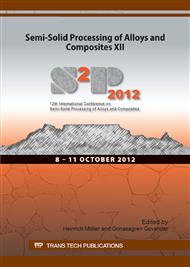p.179
p.185
p.191
p.197
p.204
p.209
p.215
p.219
p.225
The Influence of Reheating Profile on the Final Microstructure of the Semi-Solid S600 and K100 Tool Steels
Abstract:
Semi-solid processing of steel alloys has attracted the attention of researchers recently. Many attempts have been carried out for the industrialization of the process. High temperature nature of the steel semi-solid processing compared to other semi-solid alloys has been a problem in studying different process parameters like reheating parameters and microstructures continuously and simultaneously. In this research in-process and final microstructures of semi-solid steel alloys M2 and K100 under different reheating cycles and different parameters have been studied. All experiments are carried out in a resistance furnace and in an argon controlled atmosphere to avoid any oxidation and decarburization. During the reheating cycle, surface and core temperature of the samples have been recorded and compared with the oven temperature. The result of such a comparison can be used in other experiments where there is no access to sample for its temperature control or it is very difficult to measure the sample temperature like in rheology tests. Partial reheating and quenching has been used to determine the in-process microstructure of the alloy. For each set of experiments particle shape factor has been derived and its relation to other parameters has been studied. Finally appropriate reheating cycle and parameters for each alloy has been determined.
Info:
Periodical:
Pages:
204-208
Citation:
Online since:
October 2012
Authors:
Keywords:
Price:
Сopyright:
© 2013 Trans Tech Publications Ltd. All Rights Reserved
Share:
Citation:


